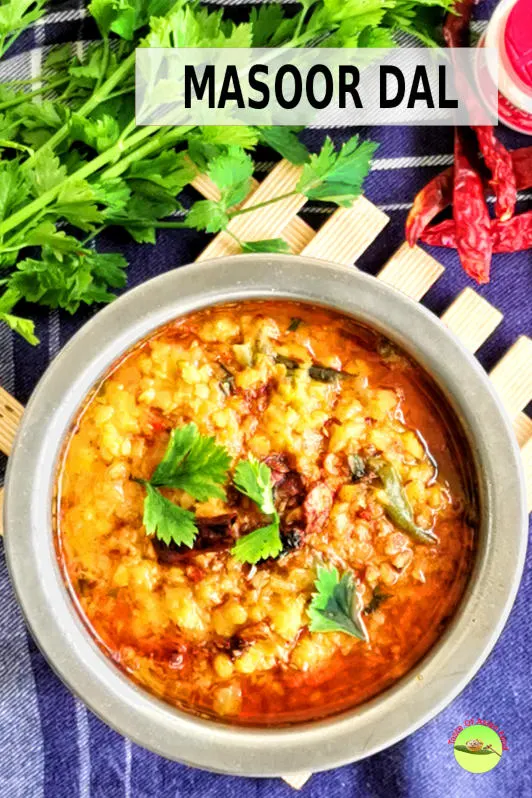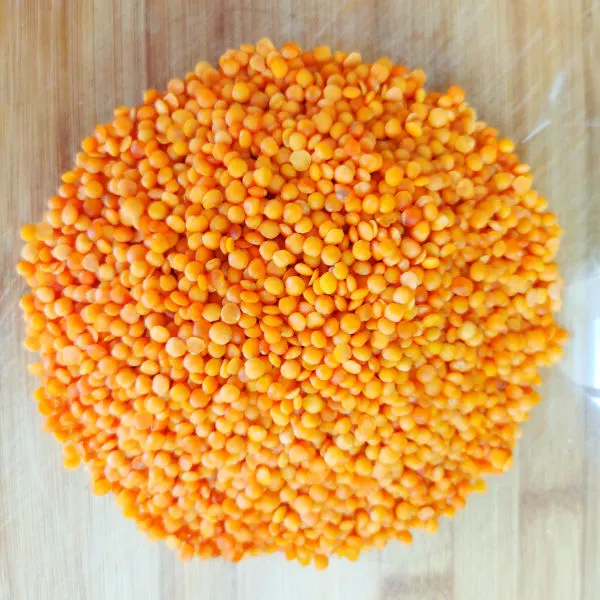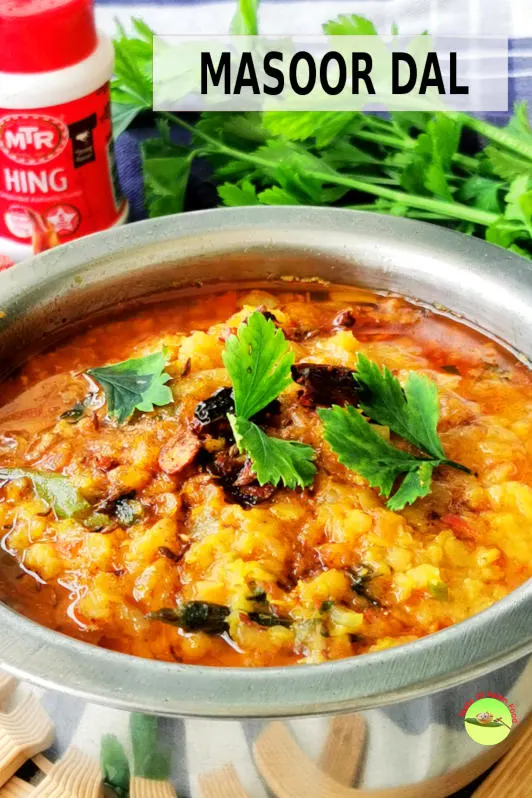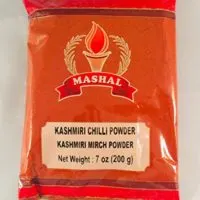Masoor dal is my favorite lentil recipe for a few reasons. First, it is the fastest lentil to cook, only fifteen minutes after soaking. Secondly, it is high in protein, making it an ideal choice for vegetarians who want to obtain a balanced nutrition.
Masoor dal with husked removed and can disintegrate in a short time during cooking. It is also called dhuli masoor dal, split masoor dal, and split red lentils in English. This lentil is also referred to as red masoor dal, pink lentils, and orange lentils since it has a pinkish color. The unhusked masoor dal (sabut dal, whole dal) is dark brown. It takes much longer to cook since the fiber content is higher and should be soaked for 3 to 4 hours before boiling. We will cover this dal in another article.

Note: This post may contain affiliate links. Please read my privacy policy for more info. I may receive commissions for purchases made through links in this post. As an Amazon Associate, I earn from qualifying purchases.
How to cook masoor dal
This masoor dal recipe can be accomplished quickly, making it my go-to recipe whenever I plan to cook dal.
Here are the detailed steps to making the masoor dal.
1. Clean and soak the lentils
- Do a visual inspection after purchasing the masoor dal. Most of the dal I bought are relatively clean, but it is worth taking a quick look to spot any small stones.
- Let the masoor dal pass through a wire mesh strainer to remove any sand and debris.
- Rinse the lentils by placing them in a larger bowl. Swirl around the water and change it a few times until it runs clear.
- Add some water enough to cover the lentils at least one inch above the surface. The lentils are hungry for water and can suck up all the water if there is insufficient water. Set it aside for thirty minutes.
- Now the lentils are ready for cooking.

2. Prepare the masala mix
The flavor of this recipe mainly depends on the masala base. Don’t be intimidated by the long list of herbs and spices in the recipe. The preparation is straightforward and easy. Once you have all these ingredients ready, it can be completed in a jiffy.
- Heat two tablespoons of ghee in a frying pan. Ghee is preferred, but you can use any vegetable oil with a high smoking point as the alternative.
- Start the cooking by adding the cumin seeds to the oil. The seeds will start to crackle and release their aroma. Some recipes also include a small number of mustard seeds at this point., which is optional.
- Add one sprig of curry leaves and the ginger garlic paste.
- Another ingredient to saute along with the cumin seeds is green chili. Since I am using a large green chili, I cut it into a few sections. Another way is to finely chop it and add it to the pan after sauteing the onion.
- After all the spice has turned aromatic, which will take just a minute or two, add the onion. I cut the onions into small dice to shorten the time required to become soft and translucent. The onion adds some texture to the dal since the lentils will eventually disintegrate into a paste. Besides that, it also contributes some flavor to the dal.
- Next, throw in some chopped tomatoes and cook for about 6 to 8 minutes or until it starts to disintegrate. I used to cut the tomatoes into relatively large chunks and later learned that coarsely chopped it will drastically reduce the cooking time.
3. Combine the lentils with the masala mix
- Once the tomatoes start to disintegrate (which took only six minutes with the lid on), pour the soaked lentils into the pan and mix well.
- I need to add a few more ingredients to spice up the masala base. The three import items are coriander powder, turmeric powder, and Kashmiri chili powder. They are not included in the initial tempering since it is only working for the whole herbs and spices. Turmeric powder has a bright yellow, and Kashmiri chili powder is bright red. The attractive color of dal is mainly derived from these ingredients.
- I also add some salt and garam masala. Some recipes do not include garam masala, but it does dramatically improve the overall flavor.
- Add water and the masoor dal to the pan and let it cook until it becomes soft. I use one cup (250g dry weight) of masoor dal and 3 cups (750ml) of water, which turn out to be a reasonably thick dal. You can use 4 cups of water for a more dilute dal. Since I have soaked it for thirty minutes, the lentils have absorbed plenty of water and took only fifteen minutes to turn soft.
- Since I prefer the dal to be pastier, I use a wire whisk to further break down the lentils.
- Then I add a teaspoon of my favorite herbs, kasuri methi, to enhance the flavor. It is the dry leaves of fenugreek, which has a flavor similar to concentrated celery and fennel. I like its unique taste, which is sold in many Indian foods.
- Lastly, sprinkle a large tablespoon of chopped coriander leaves, mix well and turn off the heat.
Tips:
Adjust the saltiness and thickness of the dal. If you plan to reheat the dal later, just cut short the cooking time by five minutes to avoid losing the texture after reheating.
4. Prepare the tadka
The last step is to prepare a set of freshly tempered herbs and spices and pour it on the dal before serving. The tadka will significantly enhance the flavor and the presentation since it adds a thin layer of red chili oil and spices on the surface.
Here are the steps for the tadka:
- Heat some ghee in a small pan.
- Add the cumin seeds, hing, dried chili, and Kashmiri chili powder.
- Let the spices splutter and crackle for twenty to thirty seconds.
- Pour it immediately onto the top of the bowl of dal.
- Garnish with more fresh coriander leaves and serve.

Some common question about this masoor dal recipe
1. Is it necessary to cook the lentils separately?
The lentils can be cooked separately with salt and turmeric powder until soft before combining with the spice and tomato. This method is useful to cook toor dal, which takes about forty-five minutes to turn tender. If we simmer it with the onion and tomato, the tomato and onion will nearly completely disintegrate and lose texture when the toor dal becomes soft.
Masoor dal takes only fifteen to twenty minutes to cook, and therefore it is more efficient to cook with other ingredients.
2. Can I simplify the recipe by omitting some spices?
Although there is a long list of herbs and spices in the recipe, most of them are standard items in the Indian kitchen pantry.
If you do not cook Indian food regularly, you can scale down the list for not purchasing all of them. Kasuri methi and hing are optional, although the taste will become milder in its absence.
You can also omit mustard seeds and use cumin seeds alone (which was what I did). Some people even cook without garam masala, although it does improve the overall flavor, in my opinion.
3. How much water is required to cook the perfect Masoor dal?
The amount of water suggested in the recipe is only a rough guide. I use three cups of water for each cup of masoor dal.
You can use four cups of water for a more diluted version.
The thickness of the dal also depends on whether you cover the pot during cooking. I boiled the dal with the lid on, which means the water will evaporate faster if I kept it open.
The water loss is also lesser when cooked with a pressure cooker.
Lastly, the dal will become thicker after it cools, so you need to factor in this if you want to enjoy it later.
4. What are hing, kasuri methi, garam masala, and ginger garlic paste? (If you are new to Indian cooking)
Garam masala is a spice mixture, usually consisting of cinnamon, mace, peppercorns, coriander, cumin, and cardamom. It is an essential spice mix used in Indian cuisine.
Kasuri methi is the sun-dried fenugreek leaves, with a flavor similar to the combination of fennel and celery.
It is sold as dried leaves or powder. It does not need to cook and usually sprinkle on top or stir in during the final cooking stage.
Hing (or asafoetida) is derived from the plant’s resin in the Ferula family, which is ground into small granules. It has a pungent taste, lightly spicy with onion flavor. There is no direct substitute, and you may omit it in this recipe.
Ginger garlic paste is a popular ingredient in Indian cuisine. It is made by blending an equal amount of ginger and garlic to form a paste. I made it with the electric blender by combining 4 oz of ginger and garlic and an oz of vegetable oil to facilitate blending. It can be kept in the refrigerator for a week or two. There is also ready-made ginger garlic paste available at the Asian grocery store. Another way to get around is to substitute it with an equal portion of finely minced ginger and garlic.
5. Can I substitute the masoor dal with other lentils?
You can use other lentils, but it will take a longer time to cook. It is, therefore, better to cook it separately before combining them with the masala mix. The dal tadka recipe on this blog clearly describes how to do this.
Other related recipes to Masoor Dal
Here are some of the related recipes to Masoor dal for you.
Chapati is the flatbread that is best to serve with dal. It contains little oil and is healthy and nutritious.
Chicken biryani rice is perfect with masoor dal if you want to have some rice and chicken. You can refer to this recipe, which describes how to prepare it from scratch and the quick and easy method.
Cabbage thoran is a simple recipe but with incredible flavor. What a treat if I have some chicken biryani rice drench with my masoor dal and enjoy it with cabbage thoran on the side.
Masoor Dal

Masoor dal is my favorite lentil recipe for a few reasons. First, it is the fastest lentil to cook, only fifteen minutes after soaking. Secondly, it has a high amount of protein, making it an ideal choice for vegetarians who want to obtain a balanced nutrition.
Ingredients
Ingredients A (masala mix)
- 2 tbsp ghee
- 1 tsp cumin seeds
- 1 sprig of curry leaves
- 2 tsp ginger garlic paste
- 1 green chili, cut into sections
- 150g (one medium) onion, small dice
- 300g (two medium) tomatoes, coarsely chopped
- 1/2 tsp coriander powder
- 1/2 tsp turmeric powder
- 1/2 tsp Kashmiri chili powder
- 1.5 tsp salt
- 1/2 tsp garam masala
Ingredients B (to cook the lentils)
- 250g (one cup) masoor dal
- 750ml (three cups) water
- 2 tbsp coriander leaves
- 1 tsp kasuri methi
Ingredients C (for the tadka)
- 2 tbsp ghee
- 1/4 tsp cumin seeds
- 1/4 tsp hing
- 2 dried chili, seeds removed and sectioned
- 1/4 tsp Kashmiri chili powder
Instructions
Clean and soak the lentils
- Rinse the lentils thoroughly until the water runs clear.
- Add some water and soak it for thirty minutes.
Masala mix
- Heat two tablespoons of ghee in a frying pan.
- Start the cooking by adding the cumin seeds to the oil, followed by the curry leaves, the ginger garlic paste, green chili.
- After they turned aromatic, add the chopped onion.
- Next, throw in the chopped tomatoes and cook for about 6 to 8 minutes or until it starts to disintegrate.
- Add the remaining ingredients in A, mix well.
Cook the lentils
- Add the soaked lentils and three cups of water, simmer for fifteen to twenty minutes.
- Break down the lentils with an egg beater.
- Sprinkle the kasuri methi, a large tablespoon of chopped coriander leaves, mix well and turn off the heat.
Prepare the tadka
- Heat some ghee in a small pan.
- Add the cumin seeds, hing, dried chili, and Kashmiri chili powder.
- Let the spices splutter and crackle for twenty to thirty seconds.
- Pour it immediately onto the top of the bowl of dal.
- Garnish with more fresh coriander leaves and serve.
Recommended Products
As an Amazon Associate and member of other affiliate programs, I earn from qualifying purchases.
Nutrition Information:
Yield:
2Serving Size:
1Amount Per Serving: Calories: 945Total Fat: 64gSaturated Fat: 27gTrans Fat: 0gUnsaturated Fat: 26gCholesterol: 166mgSodium: 4053mgCarbohydrates: 52gFiber: 10gSugar: 9gProtein: 45g
This data was provided and calculated by Nutritionix on 12/12/2020





Deborah
Thursday 15th of April 2021
Thank you, a delicious recipe. Very forgiving, as I had to make a few substitutions on ingredients. used split dal and tripled the recipe and using approximately 4 cups of water. Did not see how to rate.
KP Kwan
Friday 16th of April 2021
It serves only as a guideline. Ultimately what you like most is the best recipe. By all means, making changes to suit your tastebuds. Cheers.
sohbet
Sunday 20th of December 2020
wery wery nice
vijaya
Saturday 19th of December 2020
I cook masoor dal in two ways. 1. wash the dal nicely put in pressure cooker add tomatoes as required,add ginger garlic paste,turmeric, red chilly powder, cumin powder, corainder powder,salt and pressurr cook for 2 to 3 whistles. once cool mash with wire to mix. Now to make tadka. tadka is done putting 2tsp ghee add chopped garlic snd some cumin seeds option green chilly and fry them lightly add to dal. put corainder on top. second method similar to.above just add washed and chopped spinach or palak and rest all same, this tastes yummy with roti.
KP Kwan
Sunday 20th of December 2020
Thank you for sharing your recipe with our readers. You are much appreciated.
Yash Pal
Thursday 17th of December 2020
'Can I substitute the masoor dal with other lentils'. Only Masoor dal lentils in English. Others are pulses, legumes etc but not lentils. Please correct.
KP Kwan
Friday 18th of December 2020
Yes, you can use other types of lentils too, for example, toor dal.
Ajay
Wednesday 16th of December 2020
You can add bit of bacon bits or ham and fry with masala. This will be enhance flavor for Indus culture society recently in news for wide variety of meat consumption.